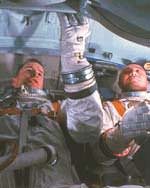
Image credit: NASA
NASA memorialized the Apollo 1 crew — Gus Grissom, Ed White and Roger Chaffee — by dedicating the hills surrounding the Mars Exploration Rover Spirit’s landing site to the astronauts. The crew of Apollo 1 perished in flash fire during a launch pad test of their Apollo spacecraft at Kennedy Space Center, Fla., 37 years ago today.
“Through recorded history explorers have had both the honor and responsibility of naming significant landmarks,” said NASA administrator Sean O’Keefe. “Gus, Ed and Roger’s contributions, as much as their sacrifice, helped make our giant leap for mankind possible. Today, as America strides towards our next giant leap, NASA and the Mars Exploration Rover team created a fitting tribute to these brave explorers and their legacy.”
Newly christened “Grissom Hill” is located 7.5 kilometers (4.7 miles) to the southwest of Spirit’s position. “White Hill” is 11.2 kilometers (7 miles) northwest of its position and “Chaffee Hill” is 14.3 kilometers (8.9 miles) south-southwest of rover’s position.
Lt. Colonel Virgil I. “Gus” Grissom was a U.S. Air Force test pilot when he was selected in 1959 as one of NASA’s Original Seven Mercury Astronauts. On July 21, 1961, Grissom became the second American and third human in space when he piloted Liberty Bell 7 on a 15 minute sub-orbital flight. On March 23, 1965 he became the first human to make the voyage to space twice when he commanded the first manned flight of the Gemini space program, Gemini 3. Selected as commander of the first manned Apollo mission, Grissom perished along with White and Chaffee in the Apollo 1 fire. He is buried at Arlington National Cemetery, Va.
Captain Edward White was a US Air Force test pilot when selected in 1962 as a member of the “Next Nine,” NASA’s second astronaut selection. On June 3, 1965, White became the first American to walk in space during the flight of Gemini 4. Selected as senior pilot for the first manned Apollo mission, White perished along with Grissom and Chaffee in the Apollo 1 fire. He is buried at his alma mater, the United States Military Academy, West Point, N.Y.
Selected in 1963 as a member of NASA’s third astronaut class, U.S. Navy Lieutenant Commander Roger Chaffee worked as a Gemini capsule communicator. He also researched flight control communications systems, instrumentation systems, and attitude and translation control systems for the Apollo Branch of the Astronaut office. On March 21, 1966, he was selected as pilot for the first 3-man Apollo flight. He is buried at Arlington National Cemetery, Va.
Images of the Grissom, White and Chaffee Hills can be found at: http://www.jpl.nasa.gov/mer2004/rover-images/jan-27-2004/captions/image-1.html
The Jet Propulsion Laboratory, Pasadena, Calif., manages the Mars Exploration Rover project for NASA’s Office of Space Science, Washington, D.C. JPL is a division of the California Institute of Technology, also in Pasadena. Additional information about the project is available from JPL at http://marsrovers.jpl.nasa.gov and from Cornell University, Ithaca, N.Y., at http://athena.cornell.edu.
Original Source: NASA/JPL News Release
